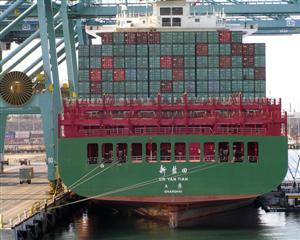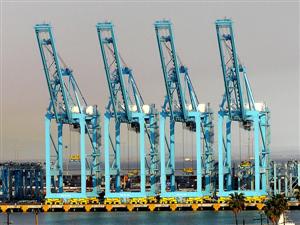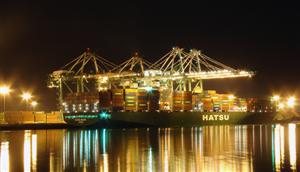September 2008 TRUCKER TALK
BIG CHANGES AT THE PORTS
BY WRITER & OWNER OPERATOR KIM GRIMM
The Port of Los Angeles is the busiest port in the United States. It is located 20 miles south of downtown Los Angeles on San Pedro Bay. And if you combine it with its neighbor, the Port of Long Beach, they become the 5th busiest in the world. But could that change? Much of how these ports operate is changing, and with the way things are going, it might be hard for many owner operators and small fleets to continue hauling freight in and out of these vital chains of commerce.
Originally, the San Pedro Bay was a shallow mudflat, too soft to support a wharf. Visiting ships had two choices – stay far out and anchor, having their goods and passengers ferried to shore, or beach themselves. Phineas Banning dredged the channel to Wilmington in 1871 to a depth of 10 feet and greatly improved shipping. In 1868, Banning built a railroad to connect San Pedro Bay to Los Angeles, the first in the area. He also owned a stagecoach line that connected San Pedro to Salt Lake City, Utah and to Yuma, Arizona. In 1885, after his death, his sons pursued his interest in promoting the port and that year it handled 500,000 tons of freight. That doesn’t sound like much today, especially for a whole year. In 2007, the port handled 190.1 million metric revenue tons of freight!
Collis P. Huntington and the Southern Pacific Railroad wanted to create the Port of Los Angeles in Santa Monica, so they built a long wharf there in 1893. But U.S. Senator Stephen White and L.A. Times publisher Harrison Gray Otis pushed for federal support of the Port of Los Angeles at San Pedro Bay. In 1897, the matter was finally settled when San Pedro was endorsed by a commission headed by Rear Admiral John C. Walker. Construction of the breakwater for the port began in 1899 with the support of the U.S. government. The port was officially founded on December 9, 1907 and then the entire area was annexed to Los Angeles in 1909.
 During the 1920’s, the Los Angeles Port surpassed San Francisco as the West Coast’s busiest seaport. During WWII, the primary use of the port was shipbuilding, employing more than 90,000 people. In 1959, Matson Navigation Company’s Hawaiian Merchant delivered the first twenty containers to the port and thus began the shift to containerization at the port. Further increasing the traffic and expansion of the port was the opening of the Vincent Thomas Bridge in 1963. Today, the port encompasses some 4,200 acres of land and 3,300 acres of water, along 43 miles of waterfront, and employs over 16,000 people. The Los Angeles Port Police are utilized to fight crime and terrorism, along with the Los Angeles City Lifeguards.
During the 1920’s, the Los Angeles Port surpassed San Francisco as the West Coast’s busiest seaport. During WWII, the primary use of the port was shipbuilding, employing more than 90,000 people. In 1959, Matson Navigation Company’s Hawaiian Merchant delivered the first twenty containers to the port and thus began the shift to containerization at the port. Further increasing the traffic and expansion of the port was the opening of the Vincent Thomas Bridge in 1963. Today, the port encompasses some 4,200 acres of land and 3,300 acres of water, along 43 miles of waterfront, and employs over 16,000 people. The Los Angeles Port Police are utilized to fight crime and terrorism, along with the Los Angeles City Lifeguards.
Waiting to be unloaded at any time is usually a backlog of ships. This has been the case since 2002. Many analysts believe that the port may have exceeded its physical capacity, as well as the capacity of local railroads and freeways, some six years ago. Ripple effects throughout the American economy are being caused by the chronic congestion at the port. This backlog also disrupts “just in time” inventory practices of many companies. There have been attempts to reduce congestion at the port, like proposing that it begin operating 24-hours a day, but this and other ideas have been encountered with resistance from the container companies, shippers, companies that receive the goods, unions and local citizens. But doesn’t it make sense? Not only would it allow more time for more work, but it would also let many of the port truckers run at night when there isn’t as much congestion on the freeways (which would also help to alleviate some traffic for everyone else during the day).
Part of the problems with congestion in the port is also the workers. Have you ever had a “have to meet the boat” load? You can’t be late, but when you get to the port, it seems that it’s usually no big hurry to get you unloaded. Most drivers I’ve talked to that go to the port tell about how “independent” the longshoreman can be. These are the folks that work at the port. And when you’re in a port, any port, you are at their mercy. These are extremely good paying union jobs, and even the longshoreman I talked to isn’t happy with the way things work and how some manipulate the system and take advantage of it. Many of the port truckers complain about how long they have to wait to be loaded or unloaded, and in a port, you can’t take in a lumper or do it yourself.
Some of the jobs in the port will most likely be going away sometime soon – more automation means less workers. What used to take 18 clerks to check in a ship can now be done with only four. Bar codes on the containers are scanned and the clerks are just there to make sure the system is working properly. But with all that heavy equipment and large freight moving around, any port is a dangerous place to work. Not paying attention for just one second can cost someone their life – and sometimes it does. So, in some ways, those high union wages are justified for some of the folks working out on the docks.
In 2007, the number of vessels arriving in the port was 2,730 – down from 2,912 in 2006 – but the vehicles used to unload the vessels went from 154,059 in 2006 to 165,712 in 2007. The top containerized imports for 2007 were furniture, apparel, automobile parts, electronic products and toys. The top containerized exports were paper, paperboard and wastepaper, scrap metal, grains, wheat and soybean products, fabrics and raw cotton, and pet and animal feed. With all these massive ships, bringing in huge amounts of freight, there has to be lots of trucks to haul everything from the docks to local warehouses and distribution centers. But not every truck in the port is there to pickup a container – there are also oversized loads, flatbeds, car haulers and tankers adding to the total truck count of about 6,300 per day.
 But this volume of shipping does comes with a cost: air pollution. Burning low quality bunker fuel, container ships idle because most have no capability to hook to shore-generated electricity. Locomotives and trucks also idle while waiting to be loaded or unloaded. A study done by the local air quality regulatory agency found that the air pollution from the port is responsible for 2,000 cases of cancer per million people (25 per million is the upper limit being sought by regulators). The port generates 47 tons of nitrogen oxides daily by marine vessels. This number nearly equals the amount of pollution emitted by the 350 largest factories and refineries in the region combined, with that number expected to increase 70% by 2022.
But this volume of shipping does comes with a cost: air pollution. Burning low quality bunker fuel, container ships idle because most have no capability to hook to shore-generated electricity. Locomotives and trucks also idle while waiting to be loaded or unloaded. A study done by the local air quality regulatory agency found that the air pollution from the port is responsible for 2,000 cases of cancer per million people (25 per million is the upper limit being sought by regulators). The port generates 47 tons of nitrogen oxides daily by marine vessels. This number nearly equals the amount of pollution emitted by the 350 largest factories and refineries in the region combined, with that number expected to increase 70% by 2022.
The vessels and cargo handling equipment were initially targeted by the Board of Harbor Commissioners in October 2002 when an initiative was implemented called the Port of Los Angeles Clean Air Program. Then, on November 20, 2006, the governing boards of the ports of Los Angeles and Long Beach voted to approve the landmark San Pedro Bay Ports Clean Air Action Plan, the most comprehensive strategy to cut air pollution and reduce health risks ever produced for a global port complex. As of October 1, 2008, the “Clean Truck Program” will go forward in both ports despite pending legal action.
This radical Clean Truck Program, which will ban many older diesel trucks from serving in the ports, was designed to encourage rapid improvement of air quality in the region. Most trucks built prior to 1989 that do not meet the federal EPA’s 2007 clean truck standards will not be allowed in the port. The program will use grants and financial incentives that, in theory, will allow trucking companies to accelerate the replacement of these older, high polluting trucks with the newer, cleaner ones. Subsidies are also being provided to encourage the use of emerging technologies and alternative fuels for powering these newly-purchased, cleaner running trucks.
Although the Clean Truck Program is focused on the trucks in the port, the biggest polluters are the vessels (ships) and the railroads. These companies are going to have to clean up their acts, too, but they get more time than the truckers. Isn’t that a big surprise? I don’t have a problem cleaning up the air, who wouldn’t want to breathe clean air? But why don’t these people making the regulations start with the biggest polluters instead of targeting, yet again, the truckers? I guess it is easier to “shut the gate” on a truck that is too old and doesn’t meet the new standards, versus telling a fully-loaded ship that it can’t come in because it does not meet the new requirements.
How many ships do you think we could turn away before they just decided to start sailing to other ports – and take all that business with them – to a port without all these restrictions? Mexico comes to mind. The town of Ensenada, which is only 70 miles south of the border town of Tijuana, already has a deep water port. It currently is not part of any rail transport grid, but there are plans to build a rail line to the United States border in the near future. This and other new ports can’t currently meet the demands, but do you really believe they won’t begin to grow and expand as the more stringent rules and regulations force the trucks and ships away from California ports?
It will be interesting to see how it will all play out. As it stands right now, there are going to be lots of changes for trucks and truckers in the California ports, and we’ll see how long it takes these regulations to make their way across the country and be adopted in ports further east. It always seems like what California does today, eventually ends up spreading across the rest of the country tomorrow.
And it’s not just the ports in California that are putting the squeeze on truckers in regards to pollution – idling laws are the craze everywhere. It’s good not to idle, but couldn’t they put some common sense into these regulations? I think we should turn off the air conditioners this summer in the capital buildings of every state. Isn’t that what they are asking us to do – turn off the air conditioning in our office? And in the winter, let’s turn off their heat! Can you imagine how much energy that would save? Can you imagine the outrage? How could we even think of something so crazy and unfair? But it’s exactly what they’re asking us to do. Think about it.
Hopefully, the port authorities can implement sensible regulations and time frames that don’t effectively shut their port down or significantly decrease its volume of freight. The air might end up being cleaner, but if nobody can find a job, there won’t be anybody left in these coastal areas to enjoy it. Both of the ports in Los Angeles and Long Beach are not only rich in history but vital to the commerce of the West Coast and beyond. For all the truckers and other workers in these two important international seaports, I hope that never changes!
